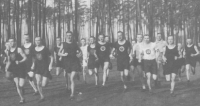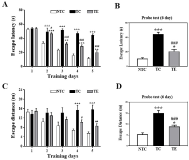The purpose of this paper is to map how sport sociologists and sport historians have engaged in the study of race and/in sport. Focusing on scholars with two communities of the North American Society for Sport Sociology & Sport History, it investigates themes, historical/sociological philosophy, theoretical/methodological issues that underpin their works. To be more specific, mainly four types of research are detailed: 1) popular narratives that mostly celebrate black athletes’ success in sport, 2) so-called the early academic works that highlight the positive role of sport in advancing the issue of race in relation to social justice, unification, equality, and so on, 3) a group of researches informed by the positivism, which attempt to discover, investigate, identify racially problematic phenomena, incidents, policies, or incidents and explain why they happen, what makes them problematic, and how to solve such matters, and 4) critical paradigm that orients cultural studies based researches that attempt to explore the relationship between sport and race with focus on interpretive, theoretical, and reflective approaches. In conclusion, it is discussed why I pay attention to the critical paradigm, what it’s emergence means to the sporting academy, and in what ways we can embrace it into the Korean sporting academy.

Based on the expanding concept of public value in most of areas as well as in public administration, the purpose of this study is to explore the meaning and functions of public value in sport pedagogy in Korea. For doing this, this paper has classified the concept of public value into classical and modern concepts and re-conceptualized it throughout diverse concepts implemented in several areas (e.g., social welfare, media, & culture-arts). Thus, this paper has explored the meaning of public value in sport pedagogy for analyzing the common element among the public values of sport, education, and scholarship. The public value of sport pedagogy is conceptualized as ‘the discipline that has inquired the public knowledge and also that has been served the instrumental role for making better society’. In addition, this paper has suggested the conceptual framework to extend the areas that can be applied the public value of sport pedagogy inside and outside in Kinesiology with reflection about academic and practical activity of Sport Pedagogy. Lastly, this paper has searched the multiple functions of public value in Sport Pedagogy such as educational, cultural, integrative, and global functions that could connect the academic and professional activity of Sport Pedagogy into making the public value of Sport Pedagogy.



The research is to shed new light to historical meaning and value of Carl Diem who was a pillar of modern sports in Germany and also served as an athlete, PE administrator, journalist, sports scholar and dean of a university. He has been highly regarded in Korea as a trail-blazer of German sports, but in his own country, he who once served as the secretary general of the 1936 German Olympics was at the center of controversy since he was named as a pro-Nazi, and even the name of a place named after him was deleted. Having said that, as an athlete, he played a huge role in organizing sports clubs where he worked as an chairman; organized and held various sports competition events; laid the academic groundwork for the modern sports in Germany by majoring in Sports in the United States. Above all, he is the one who came up with the torch relay and staved to define the significance of the Olympic Games by founding the International Olympic Academy. His academic and practical capabilities were proven through the establishment of Deutsche Sporthochschule Köln, also known as German Sport University Cologne. And Carl Diem Research Institute is still up and running to this day. Thus, in this research, I’d like to take a look at his passion for sports and changes of German sports including the German Olympics and offer a multi-faceted view on him who was evaluated during a historical turmoil back then.



PURPOSE This study first investigated how different types of sport team logos (emblem vs. mascot) influence consumer behavior through warmth and competence and then examined the moderating effects of consumer characteristics (gender) and contextual cues (perceived competence) on these relationships. METHODS A nationwide sample of adults age 20 was selected using quota random sampling based on gender. A 2 (logo type: emblem vs. mascot) × 2 (gender) × 2 (contextual cue: high competence vs. low competence) experimental design was employed, with participants randomly assigned to each group. Confirmatory factor analysis (CFA) with Mplus 8 was employed to assess the measurement model’s reliability and validity, and hypothesis testing was conducted through structural equation modeling (SEM), measurement invariance tests, and multigroup SEM analysis. RESULTS Findings indicate that anthropomorphized mascot logos, compared to emblem logos, generate more positive attitudes and psychological responses (warmth and competence) to the team. Gender’s moderating effect on the relationship between logo type and consumer perceptions (warmth and competence) was not significant, but contextual cues’ moderating effect was partially significant. CONCLUSIONS This study highlights of perceived warmth and competence’s crucial role in shaping consumer attitudes toward sports teams through logo design. These findings offer meaningful insights for sports teams and marketers to optimize branding strategies and enhance fan engagement.
PURPOSE Through analysis, this study reports on occurrences of children and adolescents’ sports accidents and presents measures to prevent, cope with, and manage school sports accidents. METHODS The study used both quantitative and qualitative methods. First, a frequency analysis was conducted using 284,429 safety accident data of the School Safety and Insurance Association (SSIA). Second, the inductive analysis method was applied to in-depth interviews conducted with eight teachers. RESULTS , accidents are characterized as follows: 1) At the school level, accidents have increased significantly every year in a large proportion of elementary and middle schools. 2) The span of time spent on sports was large. 3) Accidents happened at playgrounds and auxiliary facilities. 4) Accidents happened during kindergarten play and ball sports in schools. 5) The descending order of days with the most accidents was Thursday, Tuesday, Friday, Wednesday, Monday, Saturday, and Sunday. 6) Rather than a certain month, accidents happened across the school semester. 7) Most accidents occurred from 10 a.m. to 2 p.m. Second, field teachers’ stories were categorized into the following topics. 1) School accidents can occur anytime, anywhere. Whether mild or serious, they still had the burden of inevitable accidents. 2) Required: were prompt response and handling by appropriate teachers; timely treatment and recovery cost support; also procedurally simplified handling by SSIA was helpful. 3) Avoiding accidents requires the following:: regular operation of safety education programs; daily promotion of teachers’ preventive observation and close guidance; and active role reinforcement of SSIA and policy support. CONCLUSIONS Finally, measures to prevent, cope with, and manage school safety accidents were proposed.
PURPOSE This study aimed to identify and establish ESG activity assessment factors tailored for sports brands, offering a foundational framework for fostering sustainability within the sports industry. METHODS A Delphi survey was conducted between December 1, 2022, and January 31, 2023, involving university professors, sports brand executives, ESG researchers, sports marketing majors , a nd sports brand influencers. Data were analyzed using SPSS WIN 24.0 and MS Excel, encompassing research subject classification, consistency verification, and empirical analysis. RESULTS The assessment of ESG activity evaluation factors of sports brands revealed that governance, social, and environmental dimensions ranked in descending order of relative importance. Among specific evaluation criteria, the adoption of employee ethics regulations was deemed paramount in the governance evaluation area, while support for stakeholder welfare and social well-being took precedence in the social evaluation category. In the environmental sector, the production and delivery of eco-friendly, durable products held the highest significance. Further analysis, considering the weighted priorities of all evaluation factors, emphasized the importance of factors, such as the adoption of employee ethics regulations, support for stakeholder welfare, social well-being, and the production and delivery of eco-friendly, durable products. Conversely, disclosure of company information and issues, support for the underprivileged, and general shareholders' meeting or agenda for the protection of shareholders' rights and interests ranked lower. CONCLUSIONS In summary, this study validates the role of governance (G) aspects within ESG activities for sports brands, alongside environmental and social dimensions. It highlights the importance of a balanced ESG framework, particularly in an era marked by heightened social responsibility awareness among consumers. Prioritizing governance in marketing strategies not only distinguishes sports brands but also necessitates impactful promotion and advertising efforts.
PURPOSE This study aims to provide empirical foundational data for the development of a new profit model in Korean professional baseball. It does so by examining the influence of professional baseball NFT product attributes on customer perceptions of value, satisfaction, and purchase intention. METHODS Data were collected from consumers who have experience purchasing KBOLLECT. A total of 363 samples were collected for analysis. Surveys were utilized for data collection, encompassing 39 items that measured product characteristics, perceived value, satisfaction, purchase intention, and demographic information. Using the collected data, various statistical analyses were conducted including descriptive statistics, exploratory factor analysis, reliability analysis, correlation analysis and multiple regression using SPSS version 21. The ensuing results from the correlation analysis and multiple regression analysis are as follows. RESULTS Product features, including aesthetics, symbolism, and scarcity, had a positive impact on consumer’s perceived emotional value. Moreover, product features, encompassing aesthetics, symbolism, scarcity, and creativity played a significant role in enhancing consumer’s perceived economic value. Furthermore, product attributes such as aesthetics, symbolism, and creativity positively contributed to consumer’s perceived social value. Similarly, product features comprising aesthetics, scarcity, creativity, and symbolism positively affected consumer’s perceived intellectual value. Additionally, the research revealed that product features related to aesthetics, symbolism, creativity, and scarcity were instrumental in bolstering consumer. Importantly, these very attributes, including aesthetics, symbolism, scarcity, and creativity, exhibited a positive influence on consumers’ purchase intentions. CONCLUSIONS In conclusion, this study underscores the substantial impact of professional baseball NFT product characteristics on consumers’ perceptions, satisfaction, and purchase intentions. To maintain enduring relationships with consumers who engage with professional baseball NFT products, it is essential to fortify these product attributes and offer diverse services utilizing them.
PURPOSE This study aimed to apply a capacity building program to sport life skill leaders and to provide cases of this process. METHODS The study participants included four leaders (male=2, female= 2, Mage=37.5) who were managing a sport life skills program at a university. They participated in a capacity building program, which consisted of (a) understanding (leader seminar), (b) application (managing the sport life skills program), and (c) evaluation (leader’s self-reflection), which were conducted in eight sessions. Four leaders conducted self-evaluations using program quality assessment (PQA) during every session, and quantitative and qualitative data were collected. Qualitative data were derived using a cross-case analysis, and quantitative data were used for calculating the effect size after performing the paired t-test. RESULTS Analyzing the reported cases of sport life skill leaders, the use value of the capacity building program was identified. Furthermore, the cases reported by the four leaders enabled observation of how the leader’s capabilities were strengthened. In the paired t-test, the effect size of physical and psychological safety, appropriate structure, supportive relationship, opportunities to belong, support for efficacy mattering, opportunities for life skill building, excluding integration of family, school, and community effort, were all significant. All effect sizes were found to have “very large effects.” CONCLUSIONS The capacity building program played a positive role in strengthening the leaders’ life skill coaching capabilities. These findings have practical implications—chiefly, it is important to strengthen leaders’ or coaches’ capabilities in order to foster life skill development and transfer of student-athletes.
PURPOSE This study investigated the associations between mental health and physical activity with all-cause mortality in persons with disability. METHODS A total of 595 participants (39.3% women) aged 45≥ years, who participated in the Korean longitudinal study of aging (KLoSA) were included in this study. The Korean version of mini-mental state examination (K-MMSE) and the center for epidemiologic studies depression scale (CES-D) were used to assess cognitive impairment and depressive symptoms, respectively. The participants were classified into active and inactive groups based on physical activity of 150 min/week. Cox’s proportional regression analyses were used to determine the hazard ratio (HR) and 95% confidence interval (CI) of mental health and physical activity relating to all-cause mortality. RESULTS During the follow-up period (11.8±4.1 years), a total of 218 (36.6%) deaths occurred from all-causes. Participants in the inactive group had significantly higher cognitive impairment (p =0.046), depressive symptoms (p =0.001), and all-cause mortality (p=0.037) than those in the active group. Compared to participants in the normal (HR=1), cognitive impairment (HR=2.229, 95% CI=1.645-3.020, p<0.001), and depressive symptoms groups (HR=1.542, 95% CI=1.136-2.091, p<0.001), those in the inactive group had significantly higher HR related to all-cause mortality. However, in the active group, cognitive function and depressive symptoms were not associated with all-cause mortality. CONCLUSIONS The current finding suggests that the promotion of physical activity may play an important role in preventing premature death from all-causes in persons with disability, especially among those with mental health problems.

Purpose The aim of this study was to investigate the effects of treadmill exercise on mitochondrial quality control in the APP/sw transgenic mice model of Alzheimer's disease(AD). Methods The experimental mice were divided into non-tg-control (NTC, n=10), tg-control (TC, n=10), and tg-exercise (TE, n=10), and treadmill exercise was conducted for 12 weeks (15m/min, 60min, 5 times/week). And then, we measured the cognitive function using MWM and the brain cortex was evaluated to determine whether any changes in the oligomer Aβ, apoptotic-related factors, mitophagy and mitochondrial biogenesis. Results As a result, treadmill exercise significantly reduced oligomer amyloid and also had a positive effect on proteins (PUMA, Bax, Bcl-2) associated with apoptosis. In addition, through the treadmill exercise, PINK-1 decreased, and increased parkin, showing that active inhibition of mitophagy has been partially relaxed. It has been confirmed that the key autophagy markers LC3 and p62 significantly reduce p62 expression in TE group compared to TC group, and that LC3-II/LC3-I ratio tended to decrease, although not significant, increasing the activity of mitophagy. Next, proteins related to mitochondrial biosynthesis (SIRT-1, PGC-1α, Tfam, and COX-IV) have been identified, and the treadmill exercise has confirmed that the expression of all proteins has increased in part. Finally, cognitive has been shown to improve cognitive by shortening both swimming distance and time through treadmill exercise. Conclusions Thus, our finding suggested treadmill exercise alleviates cognitive dysfunction by improving mitochondrial quality control(mitophagy, mitochondrial biogenesis) and neuronal cell death via reducing amyloid accumulation, which may play a role in a preventive strategy for AD.



